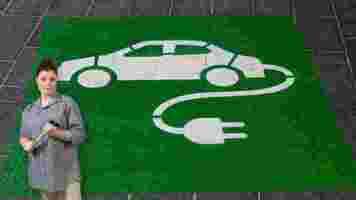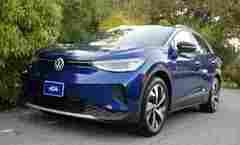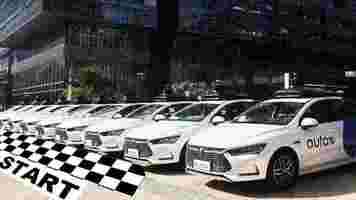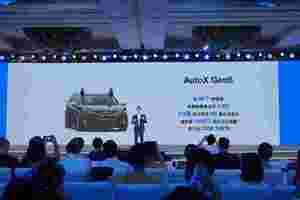How much does it cost to maintain an EV?
This article was originally published by Martin Banks on Clean Fleet Report , a publication that gives its readers the information they need to move to cars and trucks with best fuel economy, including electric cars, fuel cells, plug-in hybrids, hybrids and advanced diesel and gasoline engines.

Welcome to SHIFT Basics , a collection of tips, explainers, guides, and advice to keep you up to speed with mobility tech.
Detailing the savings from going electric
All vehicles require some form of maintenance. Whether it’s a simple repair or a regular inspection, there’s no avoiding the mechanic. If you own a vehicle for a significant amount of time, you’ll pay a visit to the shop sooner or later. EVs are no different.
That said, drivers will typically spend less on long-term maintenance than they would for an internal combustion engine (ICE) car over time. A bonus: Electric vehicles are much better for the environment. So, just how expensive is EV maintenance overall?
Average maintenance costs
The average total cost of ownership for an electric car in the United States is around half as much as a gasoline-powered vehicle. This includes the purchase price, fueling costs and overall maintenance expenses.
Perhaps this is because electric vehicles have fewer parts to care for than an internal combustion engine. Plus, they don’t require oil changes, which adds up over time for owners of gasoline-powered cars.


People who own an internal combustion engine car know maintenance fees can add up. It can cost anywhere from a few hundred to a few thousand dollars any time it goes to the shop for repair. Gasoline-powered vehicles cost around $1,200 per year to maintain compared to about $900 for electric ones. EV drivers could save at least $3,000 in maintenance over 10 years.
What does it take to maintain an EV?
There are some typical maintenance costs for electric vehicles. Like a gasoline-powered engine, electric cars require new brake pads, tire rotations and maintenance on the suspension, including steering tie rods, ball joints and shock absorbers.
Besides that, EVs also have cabin air filters. These keep all the dust, dirt and small particles out of the car’s air conditioning and heating system. They require cleaning or replacement every 36,000 miles or more frequently if necessary. (Of course, some ICE vehicles also have these filters.)
After about 10 years, you may have to replace a battery pack, which can cost more than $5,000. Additionally, a new motor can cost quite a bit of money, but it’s unlikely that will need to be replaced. Consumer Reports, the Bible for car reliability, gave EVs mixed reviews, (Tesla finished near the bottom while hybrid-heavy Toyota and Lexus were in the top three) but generally backed the premise that electrified cars should cost consumers less to keep up.
Preventive maintenance tips for your EV
Like with any vehicle, some things can be done to keep EVs running longer and at their maximum potential.
Regulate the garage’s temperature: EV batteries can wear down faster if temperatures are too high or too low. Having a sealed garage door and ensuring it’s insulated can better regulate temperatures for a longer-lasting battery.
Schedule regular inspections: EV owners should also periodically schedule an overall inspection with a professional mechanic. They can ensure the car is in proper working order and may be able to prevent future issues.
Test the motor and battery: EV motors and batteries can wear down over time. It’s essential to have them tested, so they don’t fail during driving.
Taking preventive measures can help reduce the overall costs of maintaining an electric vehicle.
Pay less with EVs
Drivers that switch to an electric vehicle will save money and the environment. Every year, EV owners pay hundreds less on maintenance and repairs. Purchasing this type of car upfront may cost more, but it ends up paying for itself over time.
Do EVs excite your electrons? Do ebikes get your wheels spinning? Do self-driving cars get you all charged up?
Then you need the weekly SHIFT newsletter in your life. Click here to sign up .
Stockholm to replace diesel boats with super fast electric ferry in 2022
This article was originally published by Christopher Carey on Cities Today , the leading news platform on urban mobility and innovation, reaching an international audience of city leaders. For the latest updates follow Cities Today on Twitter , Facebook , LinkedIn , Instagram , and YouTube , or sign up for Cities Today News.

The world’s ‘fastest all-electric’ passenger ferry is set to launch on Stockholm’s waterways in 2022, as part of a joint pilot between Swedish boat-maker Candela and the Swedish Transport Administration .
The 30-passenger ferries will shuttle passengers to and from the city’s islands at speeds up to 30 knots (55 km/h), with the intention of eventually replacing the city’s fleet of 60 diesel boats that serve commuters and tourists to and from the vast archipelago that stretches from the city center.
Speaking to Cities Today , Michaela Haga, Chair of the Maritime Public Transport Committee of Region Stockholm, said: “In our ongoing aim to further develop a waterborne public transportation system that meets the needs of today and tomorrow, we need to closely monitor, test and evaluate new techniques.
“This pilot project will provide us important insights on operation costs, comfort and how to decrease erosion. After the pilot, that will go on until 2024, we will know more if this is a future solution for our public transport on water.”
Flying ferry
The firm says the new P-30 ferry ‘flies’ on computer-controlled hydrofoils, that reduce energy consumption by 80 percent compared to the fastest ferries in service today.
The ferry can also operate in urban waterways at higher speeds than traditional passenger boats because it creates little wake that could damage nearby vessels or property.
Higher service speeds will allow the new P-30 ferry to shuttle more passengers than other electric ships, and it will be able to service longer routes because it can travel more than three hours at 20 knots (37 km/hr) cruise speeds before recharging.
Candela says a recent report by the municipality of Stockholm estimates the overall cost of operating the P-30 will be half the cost of conventional diesel ferries, and each ferry consumes energy at the same level as a modern electric-hybrid bus.
“Today, most of our waterways are unused for mass transit, even though most highways are congested during rush-hour traffic. Opening up urban waterways for high-speed electric transport can revolutionize commuting in cities such as San Francisco, Seoul or Amsterdam – at a very low cost,” said Gustav Hasselskog, the founder and CEO of Candela. “There’s no need to build new infrastructure.”
Do EVs excite your electrons? Do ebikes get your wheels spinning? Do self-driving cars get you all charged up?
Then you need the weekly SHIFT newsletter in your life. Click here to sign up .
Robotaxi race heats up in China: AutoX unveils ‘superior’ upgrade
Robotaxis are a hot business in China with autonomous cars from multiple companies already on the streets. But who’s gonna come out on top? Self-driving startup AutoX has once again thrown its hat into the ring, to get the sought-after crown.

At the Crowne Plaza Shanghai Anting yesterday, the company launched the upgraded AutoX Gen5 system, promising to offer better navigation capability, enhanced safety, and overall “superiority to the competitor’s systems.”


This seems to be an answer to Baidu’s own fully autonomous taxi service , called Apollo, which started commercial operations in Beijing in May.
Even if we take the new “superiority to the competitor’s systems” aside, AutoX might actually have quite a few advantages over Baidu.
Firstly, Baidu’s autonomous vehicles always have a safety driver on board — while AutoX’s taxis are fully driverless .
The reason is that Shenzen, where the company’s robotaxis run, is the only city in China that allows truly driverless vehicles on all public roads.
Meanwhile Baidu’s taxis are in Beijing, where they can only operate within a small specially designated zone and need to have a safety driver on hand. Similarly, such vehicles may only drive within closed campuses or zones, and for that reason Baidu is operating at Beijing’s Shougang Park, covering a 3 square kilometer range.
So while Baidu only has about 3 square kilometers for its robotaxis, AutoX’s fleet is running in Shenzhen’s Pingshan district — a much more impressive 104.6 square kilometer operational zone.
However, Baidu already has plans to expand to 30 Chinese cities and its already bagged a special promotion during the upcoming Winter Olympics, with one of the venue’s located in the robotaxi zone in Beijing. This could explain AutoX’s big push now to strengthen its position against Baidu.
So let’s take a look at what AutoX’s new upgrade actually entails.
The upgrade promises to take the company’s tech to the next level with the following:
50 sensors in total
28 cameras capturing a total of 220 million pixels per second
6 high resolution LiDAR offering 15 million points per second
4D radar with 0.9-degree resolution encompassing 360 degrees around the vehicle
AutoX believes that by adding these new features — along with an additional vehicle control unit of 2200 TOPS computing power — its robotaxis will have zero blind spots.
I have to say that Baidu’s robotaxis don’t look too good in comparison…
They’ve only got 2 LiDAR and 6 surround cameras — in total . Or well, they also got one ultrasound and one millimeter wave radar, which are adequate as supplementary functions. But their mapping capabilities and precision are far more inferior than those of a 4D radar.
All in all, it seems clear that AutoX has been taking the robotaxi game very seriously. And its reasonable to say that the Gen5 upgrade presents some notable advancements that might actually do justice to AutoX’s claims for improved safety and navigation.
Do EVs excite your electrons? Do ebikes get your wheels spinning? Do self-driving cars get you all charged up?
Then you need the weekly SHIFT newsletter in your life. Click here to sign up .